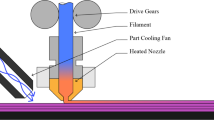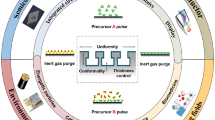Abstract
This paper deals with the planning problem in a nanodeposition manufacturing process, in which a toolbit that consists of a multilayer grid of micro/nanofluidic channels is used to deposit nanoscale liquid materials to desired positions on workparts to form solid patterns. The objective is to obtain a planning procedure that achieves efficient throughput for the studied nanodeposition manufacturing systems. We break down the studied problem into several sub-problems as design pattern decomposition, nanopore assignment, liquid material routing in the multilayer grid fluidic network, and toolbit path planning. Efficient algorithms are proposed to solve these sub-problems individually, and then finally integrated into a framework that systematically plans the nanodeposition manufacturing process. A software tool that plans, simulates, and controls the nanodeposition manufacturing process by implementing the proposed algorithms is reported in this paper.
Similar content being viewed by others
References
Gruenbaum B, Shephard GC (1986) Tilings and patterns. W H Freeman & Co, New York
Jarvis RA (1973) On the identification of the convex hull of a finite set of points in the plane. Inf Process Lett 2:18–21
Graham RL (1972) An efficient algorithm for determining the convex hull of a finite planar set. Inf Process Lett 1:132–133
Preparata F, Hong SJ (1977) Convex hulls of finite sets of points in two and three dimensions. Commun ACM 20(2):87–93
de Berg M, van Kreveld M, Overmars M, Schwarzkopf O (2000) Computational geometry: algorithms and applications, 2nd edn. Springer-Verlag, London
Karp RM (1975) On the complexity of combinatorial problems. Netw 5:45–68
Kramer MR, van Leeuwen J (1984) The complexity of wire routing and finding the minimum area layouts for arbitrary VLSI circuits. In: Preparata FP (ed) Advance in computing research 2: VLSI theory. JAI Press, London, pp 129–146
Kolliopoulos SG, Stein C (1998) Approximation disjoint-path problems using greedy algorithms and packing integer programs. Sixth International Conference on Integer Programming and Combinatorial Optimization (IPCO) 153–168, 1998, Houston, USA
Lau LC (2004) An approximate max-Steiner-tree-packing min-Steiner-cut theorem. In Proceedings of the 47th Annual IEEE Symposium on Foundations of Computer Science 61–70
Wagner D (1993) Simple algorithms for Steiner trees and paths packing problems in planar graphs. CWI Q 6(3):219–240
Suzuki H, Akama T, Nishizeki T (1990) Finding Steriner forests in planar graphs. In Proceedings of the 1st Annual ACM-SIAM Symposium on Discrete Algorithms 444–453
Tang D (2006) Logistics of fluid delivery in micro/nano fluidic networks. Ph.D. Dissertation, University of Illinois at Urbana-Champaign
Garey MR, Johnson DS (1979) Computers and intractability: a guide to the theory of NP-completeness. Freeman, San Francisco
Takahashi H, Matsuyama A (1980) An approximate solution for the Steiner tree problem in graphs. Math Jpn 24(6):573–577
Kou L, Markowsky G, Berman L (1981) A fast algorithm for Steiner trees. Acta Informatica 15:141–145
Robins G, Zelikovsky A (2000) Improved Steiner tree approximation in graphs. In proceedings of the 10th Annual ACM-SIAM Symposium on Discrete Algorithms 770–779
Sunazawa M, Hani T (1974) Low-power cross-point switch matrix for space-division digital-switching network. ISSCC Digest of Technical Papers 206–207
Ahuja RK, Magnanti TL, Orlin JB (1993) Network flows: theory, algorithms, and applications. Prentice Hall, New Jersey
Lawler EL, Lenstra JK, Rinnooy Kan AHG, Shmoys DB (1985) The traveling salesman problem: a guided tour of combinatorial optimization. Wiley, New York
Orloff CS (1974) A fundamental problem in vehicle routing. Netw 4:35–64
Christofides N (1976) Worst case analysis of a new heuristic for the traveling salesman problem. Technical Report 388, Graduate School of Industrial Administration, Carnegie-Mellon University, Pittsburgh, PA
Kruskal JB (1956) On the shortest spanning subtree of a graph and the traveling salesman problem. In Proc Am Math Soc 7(1):48–50
Prim RC (1957) Shortest connection networks and some generalizations. Bell Syst Tech J 36:1389–1401
Lawler EL (1976) Combinatorial optimization: networks and matriods. Holt, Rinehart and Winston, New York
Lin S (1965) Computer solutions of the traveling salesman problem. Bell System Technical Journal 44:2245–2269
Lin S, Kernighan BW (1973) An effective heuristic algorithm for the traveling salesman problem. Oper Res 21:498–516
Chisman JA (1975) The clustered traveling salesman problem. Comput Oper Res 2:115–119
Jongens K, Volgenat T (1985) The symmetric clustered traveling salesman problem. Eur J Oper Res 19:68–75
Guttmann-Beck N, Hassin R, Khuller S, Raghavachari B (2000) Approximation algorithms with bounded performance guarantees for the clustered traveling salesman problem. Algorithmica 28:422–437
Johnson DS (1974) Worst case behavior of graph coloring algorithms. In Proceedings of 5th South-Eastern Conference on Combinatorics, Graph Theory and Computing, Canada 513–528
Wigderson A (1983) Improving the performance guarantee for approximate graph coloring. Inf Process Lett 30:729–735
Halldórsson MM (1993) A still better performance guarantee for approximate graph coloring. Inf Process Lett 45:19–23
Author information
Authors and Affiliations
Corresponding author
Rights and permissions
About this article
Cite this article
Tang, D., Palekar, U.S. An integrated planning approach for a nanodeposition manufacturing process. Int J Adv Manuf Technol 51, 561–573 (2010). https://doi.org/10.1007/s00170-010-2651-1
Received:
Accepted:
Published:
Issue Date:
DOI: https://doi.org/10.1007/s00170-010-2651-1




